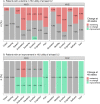Factors associated with the health-related quality of life among people with Duchenne muscular dystrophy: a study using the Health Utilities Index (HUI)
- PMID: 35690783
- PMCID: PMC9188127
- DOI: 10.1186/s12955-022-02001-0
Factors associated with the health-related quality of life among people with Duchenne muscular dystrophy: a study using the Health Utilities Index (HUI)
Abstract
Background: Data on health state utility in Duchenne muscular dystrophy (DMD) are few. This study estimated mean utility values by age, ambulatory status and over time, and investigated which aspects of health-related quality-of-life (HRQoL) are most strongly associated with utility in DMD.
Methods: Data from placebo-treated ambulant boys with DMD with exon 51 skip amenable mutations, (NCT01254019), were included. Ambulatory function assessments were conducted at baseline and every 12 weeks for the trial duration. Family member proxies completed the Health Utility Index (HUI) at baseline, 24 and 48 weeks; and HUI3 and HUI2 utility values were summarized. Changes in HUI attribute level over time, and predictors of changes in utility, were explored.
Results: Sixty-one boys (mean [range] age of 8.0 [5-16] years) were included in the analysis. Mean baseline utilities were 0.82 (HUI3) and 0.87 (HUI2); and utilities were 0.35 (HUI3) and 0.55 (HUI2) after loss of ambulation (LOA, where applicable). Over the follow-up period mean utility declined more among the older versus younger boys. Pain accounted for the highest proportion of variability (42%) in change in HUI3 utility from baseline to week 48, while for HUI2, self-care (39%) did. After LOA, change in ambulation levels explained 88% of the decline in mean HUI3 utility and change in mobility levels explained 66% of the decline in mean HUI2 utility.
Conclusions: Utility values among this sample were higher than previously published estimates. In younger boys utility remained relatively stable, but older boys and those losing ambulation experienced important declines over follow-up.
Keywords: DMD; Duchenne muscular dystrophy; HUI; Longitudinal; Utility.
© 2022. The Author(s).
Conflict of interest statement
IFA and KG are employees of Sarepta. SMS and BR are employees of Broadstreet HEOR, which received funds from Sarepta to conduct this study. DF received consulting fees related to this work. DF has a proprietary interest in Health Utilities Incorporated, Dundas, Ontario, Canada. HUInc. distributes copyrighted Health Utilities Index (HUI) materials and provides methodological advice on the use of HUI.
Figures




References
-
- McDonald CM, Henricson EK, Abresch RT, Han JJ, Escolar DM, Florence JM, Duong T, Arrieta A, Clemens PR, Hoffman EP, Cnaan A. The cooperative international neuromuscular research group Duchenne natural history study–a longitudinal investigation in the era of glucocorticoid therapy: design of protocol and the methods used. Muscle Nerve. 2013;48:32–54. doi: 10.1002/mus.23807. - DOI - PMC - PubMed
Publication types
MeSH terms
LinkOut - more resources
Full Text Sources

